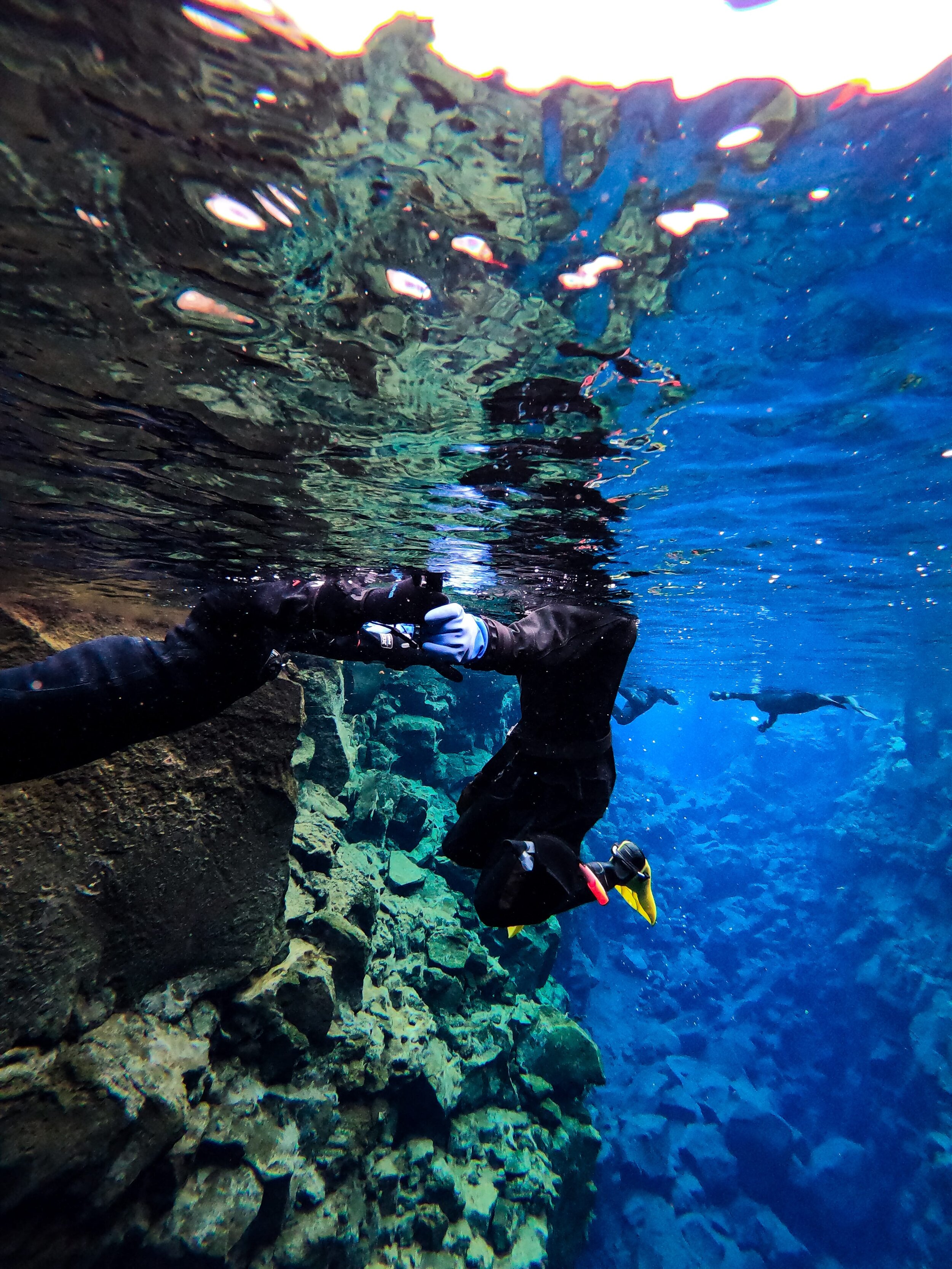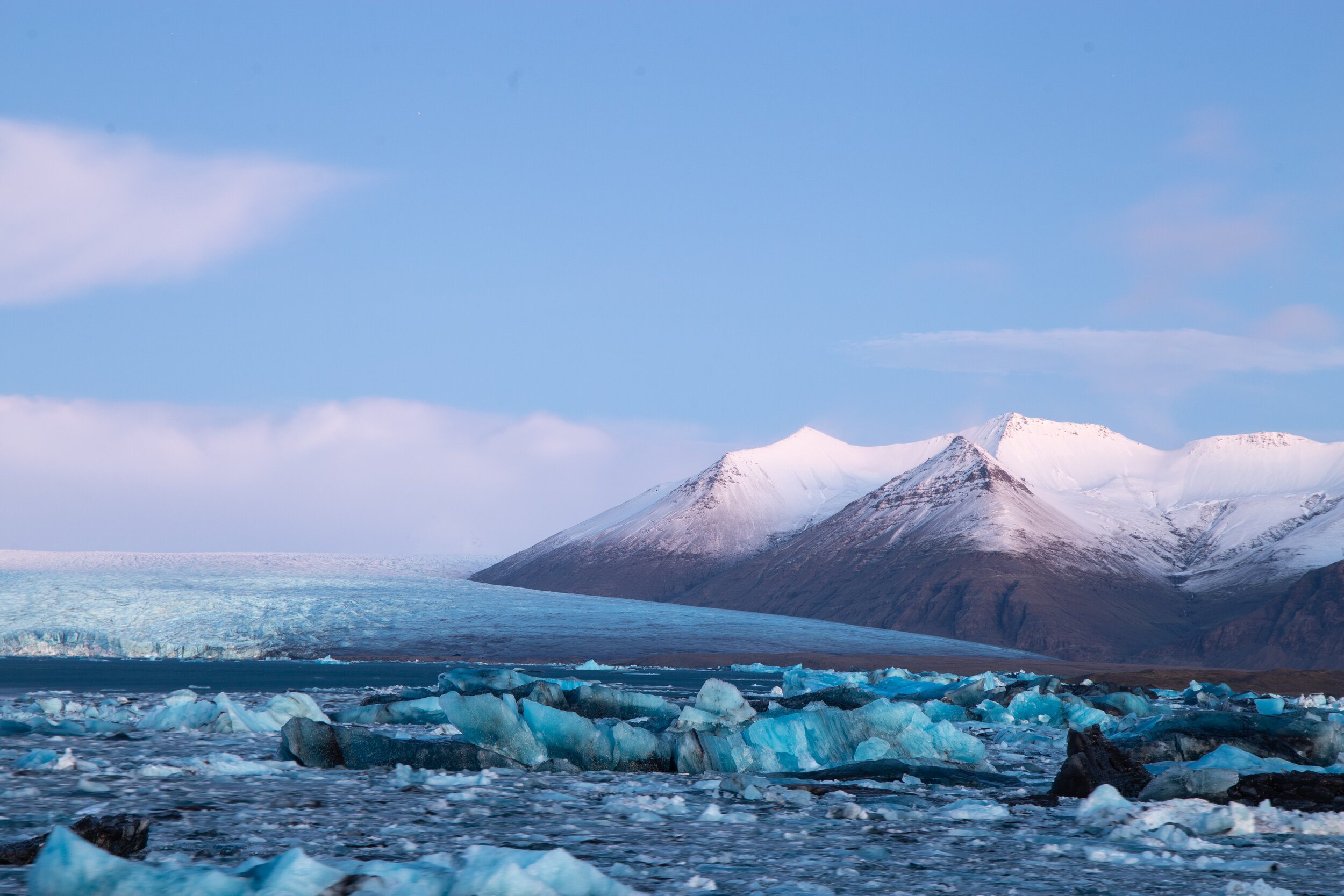Silfra
One of a kind
It may seem surprising that one of the best diving sites in the world is in Iceland of all places, with its freezing waters and rough climate. But here you will find Silfra, a truly unique site where you can dive or snorkel between two tectonic plates in the clearest water - a place like no other. It is hands down one of the best experiences you can have in Iceland and that is something, in an incredible country that has so much to offer.
The Fissure
Silfra is a fissure between the North Atlantic and Eurasian tectonic plates, located in Thingvellir National Park. The fissure opened in 1789, and the plates have been drifting apart ever since - they still do, by around 2cm every year. The fissure is situated at the northern tip of the Thingvallavatn lake, and is filled with glacial meltwater from Langjökull, Iceland’s second-largest glacier, located about 50km away. The water travels this distance underground and is filtered through fine porous lava before reaching Silfra. This process takes 30-100 years! Thus, by the time it has reached Silfra, the water is extremely pure.
As a result, the visibility at Silfra can exceed 100m, which is really impressive, and unmatched. To put things into perspective, 40m visibility at a popular diving site around the tropics is probably as good as it gets.
The water at Silfra maintains a constant temperature of 2-4°C throughout the year. This means snorkelling and diving activities can remain open all year round. Because the water constantly flows underground, there is a light current, and this prevents the water from freezing in cold temperatures, as well as becoming dirty or contaminated.
Clearly, such pure water is most suitable for drinking, so don’t forget to take a sip before you leave!
The Blue
Probably the first thing you will notice about Silfra when you look at photos is that the water is blue - a deep, vibrant, azure blue. This is very much real (no editing, no filter needed). You might ask yourself why the water is so blue. I know I did, so here’s what I made of it.
It’s blue for the same reason that the sky is blue on a sunny day, or the ice of glaciers and ice caves are various shades of blue. As light penetrates the surface, water molecules absorb photons of longer wavelengths (like red), and transmit shorter wavelengths (like blue), which are scattered and reflected back to the viewer - just like your blue t-shirt absorbs all other colours. We see what remains - blue.
The water in a glass appears transparent, as there aren’t enough water molecules to absorb anything and the light simply passes through. The water in the sea/ocean appears light blue close to the shore, and deep blue farther out. The Silfra fissure isn’t a particularly large body of water, but it’s extremely pure, meaning light can penetrate very easily and there are lots of water molecules to absorb the red, and not much else, resulting in that beautiful deep shade of blue.
Getting There
Silfra isn’t far from Reykjavik - around 50km away, a 45min drive.
Parking area P5 is closest to the assembly point for Silfra tours. Note that a daily charge of 750ISK/car applies at parking areas P1, P2, P5 within the Thingvellir National Park - the ticket is valid across all, for the day. The way this works is there are cameras that record your vehicle plate number, so there is no escaping it. You can pay this fee at the machines available at the location or online.
If you don’t want to pay a fee, you can park at P3, which is farther away, but free of charge.
I’ve marked everything on my map of Iceland.
Tours
Experiencing Silfra is one of those things you really cannot do on your own. You must join a tour.
There are several operators available, offering snorkeling or diving tours. We went with dive.is - Iceland's leading dive and snorkel tour operator - and would recommend them to anyone.
Probably best to avoid Arctic Adventures, Iceland’s largest tour operator, due to their handling of customer refunds during the pandemic (check recent reviews) - worst of all, they still try to lure customers in with the promise of “free cancellation”.
Snorkeling
Snorkeling tours are accessible to pretty much everyone, with no previous experience needed. They last about 3h overall and cost around £100. This may seem expensive, but bear in mind that any experience in Iceland that you can’t do on your own (such as ice caves, glacier hikes, lava tunnels, etc.) are around this price point or even more. For Iceland, this experience is most definitely worth it. There are commonly up to 6 people per tour and an instructor, so it’s a small group, which is nice.
The tour starts at the assembly point with a bit of history on the area, a safety briefing, and then possibly the lengthiest part of the tour, which is getting all suited up. This would be a good time (the only time!) to use the toilet.
First, you need to get into a fluffy undersuit to keep you warm - easy. It does help if you also wear your own thermal underwear (top, bottom, socks) in addition to that. Then comes the drysuit itself, a rubbery overlayer that is completely waterproof. Add in neoprene gloves, a neoprene hood, mask, fins, and your new look is complete. By the end of it, you might look something like this - I’d be scaring off all underwater life if there was any.
There is tight seal around the wrists and neck, though a little bit of water might sneak in depending on your movements. The area of your face between the mask and hood remains exposed, and this might feel really uncomfortable at first, but it’s not long before you get used to it. Aside from that, you won’t feel a thing as you swim in near-freezing water, thanks to the drysuit.
Once that is out of the way, most of the tour is already finished, but the best is yet to come!
Silfra doesn’t look like much at the surface, but once you lay your head underwater, it becomes an entirely different story. This isn’t your typical snorkeling experience. The water is freezing cold around the face and hands. Don’t go finding Nemo - there is nothing but some green-yellow algae in terms of visible underwater life. But drifting through the crystal clear water, gazing at that deep blue against the basalt rocks - it’s otherworldly. The experience is probably best enjoyed on a sunny day, but don’t worry, the blue is there even on a miserable cloudy day (a much more likely scenario in Iceland).
Personally, I would say that no swimming experience is needed at all (despite what you might think or read elsewhere), so don’t be put off by the idea of swimming through deep, glacial water for over half an hour. It takes approximately 40 minutes to travel the length of Silfra, and you don’t need to do much, as the gentle current will drift you across. The current keeps you going, while the drysuit keeps you afloat (it’s like a lifejacket). You couldn’t drown if you tried! So, even if you’re not a good swimmer, just relax and… go with the flow.
Diving
Diving takes the experience to a whole new level, however this isn’t something for everyone, as you would require diver experience with certification. If you are that person, this should be an incredible experience. Duration is 3-5h and the cost is around £175.
BBC Travel Show
It so happened that we ended up on the same tour with the crew from the BBC Travel Show, while they were filming a documentary on Iceland, so we’re in there too.
Here’s a link for the video:














Probably the most beautiful waterfall in Iceland